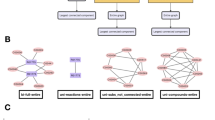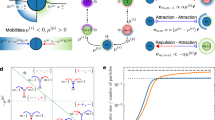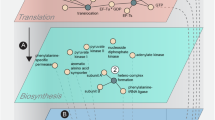Abstract
In a cell or microorganism, the processes that generate mass, energy, information transfer and cell-fate specification are seamlessly integrated through a complex network of cellular constituents and reactions1. However, despite the key role of these networks in sustaining cellular functions, their large-scale structure is essentially unknown. Here we present a systematic comparative mathematical analysis of the metabolic networks of 43 organisms representing all three domains of life. We show that, despite significant variation in their individual constituents and pathways, these metabolic networks have the same topological scaling properties and show striking similarities to the inherent organization of complex non-biological systems2. This may indicate that metabolic organization is not only identical for all living organisms, but also complies with the design principles of robust and error-tolerant scale-free networks2,3,4,5, and may represent a common blueprint for the large-scale organization of interactions among all cellular constituents.
This is a preview of subscription content, access via your institution
Access options
Subscribe to this journal
Receive 51 print issues and online access
$199.00 per year
only $3.90 per issue
Buy this article
- Purchase on Springer Link
- Instant access to full article PDF
Prices may be subject to local taxes which are calculated during checkout



Similar content being viewed by others
References
Hartwell, L. H., Hopfield, J. J., Leibler, S. & Murray, A. W. From molecular to modular cell biology. Nature 402, C47–52 (1999).
Barabási, A.-L. & Albert, R. Emergence of scaling in random networks. Science 286, 509– 512 (1999).
West, G. B., Brown, J. H. & Enquist, B. J. The fourth dimension of life: fractal geometry and allometric scaling of organisms. Science 284, 1677–1679 (1999).
Banavar, J. R., Maritan, A. & Rinaldo, A. Size and form in efficient transportation networks. Nature 399, 130–132 (1999).
Albert, R., Jeong, H. & Barabási, A.-L. Error and attack tolerance of complex networks. Nature 406, 378–382 ( 2000).
Ingber, D. E. Cellular tensegrity: defining new rules of biological design that govern the cytoskeleton. J. Cell Sci. 104, 613 –627 (1993).
Bray, D. Protein molecules as computational elements in living cells. Nature 376, 307–312 (1995).
McAdams, H. H. & Arkin, A. It's a noisy business! Genetic regulation at the nanomolar scale. Trends Genet. 15, 65–69 (1999).
Gardner, T. S., Cantor, C. R. & Collins, J. J. Construction of a genetic toggle switch in Escherichia coli. Nature 403, 339– 342 (2000).
Elowitz, M. B. & Leibler, S. A synthetic oscillatory network of transcriptional regulators. Nature 403, 335–338 (2000).
Hasty, J., Pradines, J., Dolnik, M. & Collins, J. J. Noise-based switches and amplifiers for gene expression. Proc. Natl Acad. Sci. USA 97, 2075–2080 ( 2000).
Becskei, A. & Serrano, L. Engineering stability in gene networks by autoregulation. Nature 405, 590– 593 (2000).
Kirschner, M., Gerhart, J. & Mitchison, T. Molecular ‘vitalism’. Cell 100, 79–88 (2000).
Barkai, N. & Leibler, S. Robustness in simple biochemical networks. Nature 387, 913– 917 (1997).
Yi, T. M., Huang, Y., Simon, M. I. & Doyle, J. Robust perfect adaptation in bacterial chemotaxis through integral feedback control. Proc. Natl Acad. Sci. USA 97, 4649–4653 (2000).
Bhalla, U. S. & Iyengar, R. Emergent properties of networks of biological signaling pathways. Science 283, 381–387 (1999).
Karp, P. D., Krummenacker, M., Paley, S. & Wagg, J. Integrated pathway–genome databases and their role in drug discovery. Trends Biotechnol. 17, 275– 281 (1999).
Kanehisa, M. & Goto, S. KEGG: Kyoto encyclopedia of genes and genomes. Nucleic Acids Res. 28, 27– 30 (2000).
Overbeek, R. et al. WIT: integrated system for high-throughput genome sequence analysis and metabolic reconstruction. Nucleic Acids Res. 28, 123–125 (2000).
Erdös, P. & Rényi, A. On the evolution of random graphs. Publ. Math. Inst. Hung. Acad. Sci. 5, 17–61 (1960).
Bollobás, B. Random Graphs (Academic, London, 1985).
Albert, R., Jeong, H. & Barabási, A.-L. Diameter of the World-Wide Web. Nature 400, 130–131 ( 1999).
Faloutsos, M., Faloutsos, P. & Faloutsos, C. On power-law relationships of the internet topology. Comp. Comm. Rev. 29, 251 ( 1999).
Amaral, L. A. N., Scala, A., Barthelemy, M. & Stanley, H. E. Classes of behavior of small-world networks. (cited 31 January 2000) 〈http://xxx.lanl.gov/abs/cond-mat/0001458〉 (2000).
Dorogovtsev, S. N. & Mendes, J. F. F. Evolution of reference networks with aging (cited 28 January 2000) 〈http://xxx.lanl.gov/abs/cond-mat/0001419〉 (2000).
Watts, D. J. & Strogatz, S. H. Collective dynamics of ‘small-world’ networks. Nature 393, 440– 442 (1998).
Barthelemy, M. & Amaral, L. A. N. Small-world networks: Evidence for a crossover picture. Phys. Rev. Lett. 82, 3180–3183 (1999).
Edwards, J. S. & Palsson, B. O. The Escherichia coli MG1655 in silico metabolic genotype: its definition, characteristics, and capabilities. Proc. Natl Acad. Sci. USA 97, 5528–5533 (2000).
Acknowledgements
We thank all members of the WIT project for making this invaluable database publicly available. We also thank C. Waltenbaugh and H. S. Seifert for comments on the manuscript. Research at the University of Notre Dame was supported by the National Science Foundation, and at Northwestern University by grants from the National Cancer Institute.
Author information
Authors and Affiliations
Corresponding authors
Supplementary Information
Rights and permissions
About this article
Cite this article
Jeong, H., Tombor, B., Albert, R. et al. The large-scale organization of metabolic networks. Nature 407, 651–654 (2000). https://doi.org/10.1038/35036627
Received:
Accepted:
Issue Date:
DOI: https://doi.org/10.1038/35036627
This article is cited by
-
Gene expression networks regulated by human personality
Molecular Psychiatry (2024)
-
Local flux coordination and global gene expression regulation in metabolic modeling
Nature Communications (2023)
-
The modular biochemical reaction network structure of cellular translation
npj Systems Biology and Applications (2023)
-
Greedy routing optimisation in hyperbolic networks
Scientific Reports (2023)
-
Chemical reaction networks and opportunities for machine learning
Nature Computational Science (2023)
Comments
By submitting a comment you agree to abide by our Terms and Community Guidelines. If you find something abusive or that does not comply with our terms or guidelines please flag it as inappropriate.



